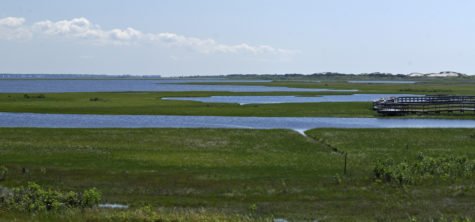By Thomas McGannA WORLD HERITAGE SITE (WHS) is a PLACE listed by the United Nations Educational, Scientific and Cultural Organization (UNESCO) as being of special cultural and/ or physical significance. Once a World Heritage Site designation has been assigned, world-class expertise can be brought to bear to protect that area. There are 1,031 sites (and counting) throughout the world, 24 of which were added in 2015 including the San Antonio Missions in Texas. The Statue of Liberty is a WHS, as are the Great Barrier Reef in Australia, Easter Island (Rapa Nui), Petra in Jordan, Machu Picchu, and the Great Wall of China.To become listed, the site must be of “universal value and meet at least one out of 10 selection criteria.” These criteria seek to protect and preserve the sites, linking the concepts of conservation with the preservation of cultural properties while recognizing the need to balance those concerns with the ways in which people interact with the sites.Fire Island meets at least three criteria as speci- fied by UNESCO:Criteria V – “to be an outstanding example of a traditional human settlement, land-use which is representative of a culture (cultures), or human interaction with the environment especially when it has become vulnerable under the impact of irreversible change.”Fire Island is a barrier island, 32 miles long by approximately 1⁄2 mile wide. Twenty-six of those miles are administered by the National Park Service (NPS) as authorized by Congress with the creation of the Fire Island National Seashore (FINS) in 1964. The Fire Island National Seashore extends 1,000 feet into the Atlantic Ocean, its southern boundary, and 4,000 feet into the Great South Bay, Patchogue Bay, Bellport Bay, Narrow Bay and Moriches Bay its northern boundaries. It also contains a number of small islands, sand flats and wetlands, along with the William Floyd Estate in Mastic Beach.Barrier beaches such as Fire Island provide indispensable protection for the mainland from flooding and erosion, and afford shelter from periodic hurricanes. As reported by the Fire Island National Seashore Short-term Community Storm Surge Protection Plan, Environmental Assessment: “Barrier islands such as Fire Island provide unique ocean- side habitat and protection from the flooding and erosion of the mainland shorelines.
Criteria VII – “to contain superlative natural phenomena or areas of exceptional beauty and aesthetic importance.”Fire Island is home to Sunken Forest, a national treasure, a very rare ecological community, and one of only two known locations on Atlantic bar- rier islands: the Sunken Forest, part of Fire Island National Seashore, New York, and the Sandy Hook holly forest, part of Gateway National Recreation Area, New Jersey.Sunken Forest has a global rarity rank, mean- ing: “Critically Imperiled or Imperiled globally – At very high or high risk of extinction due to rarity or other factors; typically 20 or fewer populations or locations in the world, very few individuals, very restricted range, few remaining acres (or miles of stream), and/or steep declines.”Fire Island Lighthouse is a historic and important aid to navigation. It was the first sighting of America for passengers on transatlantic ships arriving from Europe during the 19th and 20th centuries. Today the lighthouse is a beacon that attracts 125,000 visitors a year.
The Otis Pike Wilderness Area on the eastern reaches of Fire Island occupies eight miles of virtually pristine beaches, high dunes covered in wildflowers, and seaside artifacts. It is the only Wilderness Area in New York State.The William Floyd Estate, also a part of FINS, a 613-acre property located in Mastic Beach, was added to FINS in 1965. It once belonged to William Floyd, a signer of the Declaration of Independence.Criteria X – “to contain the most import- ant and significant natural habitats for in-situ conservation of biological diversity, including those threatened species of outstanding universal value from the point of view of science or conservation.”Fire Island is the habitat for several endangered species. The Piping Plover (Charadrius melodus) has been reduced to a population of only 6,500 and Fire Island is one its last remaining breeding areas. The Roseate Tern (Sterna dougallii), also a resident spe-cies, is federally and state endangered, as is the Least Tern (Sternula antitarum).The Seabeach Amaranth (Amaranthus pumilius), a federally threatened annual plant species, grows on Fire Island beaches. The Seabeach Knotweed (Polygonum glaucum) is another rare plant that makes Fire Island its home.Three species of endangered whales ply the waters of the Atlantic Ocean off Fire Island. They are the Humpback Whale (Megaptera novaeangliae), the Fin Whale (Balaenoptera physalus), and even the Northern Right Whale (Eubalaena glacialis). Five federally endangered species of sea turtles have been documented on Fire Island although none nest there: Kemp’s Ridley Turtle (Lepidochelys kempii), the Leatherback Turtle (Dermochelys coriacea), and the Hawksbill Turtle (Eretmochelys imbricata) are fed- erally endangered species, while the Loggerhead Turtle (Caretta caretta) and Green Turtle (Chelonia mydas) are federally threatened.There is a need for world-class expertise to pre- serve the natural treasures of the seashore and the barrier island. Addressing imminent threats to the planet because of climate change and rising sea lev- els will require the expertise obtainable through designation as a World Heritage Site. To this end, Jerry Stoddard and Irving Like have formed the Fire Island Conservancy, a 501(c) (3) not-for-profit corporation to advance the long-term protection of the barrier island and its communities, and to gain World Heritage Site status for FINS.Irving Like, Esq., one of the founders and only sur- viving member of the Citizens Committee for the Fire Island National Seashore, was, in part, responsible for the defeat of the Robert Moses highway.
Jerry Stoddard, president of the Fire Island Associ- ation from 1987 to 2011, was a bit more circumspect. “Fire Island is unique. Those who live here celebrate that. At the same time that they want to protect that fact, they want to preserve their uniqueness… It is important to remember that each individual is differ- ent. Some are interested in the commercial aspect, some want solitude. There should be a system under UNESCO, where all can be formally recognized and accepted. There is room for all.”There are, however, other well-argued points of view in opposition to the idea. The one most often voiced, is the question of sovereignty. Will the UN, through UNESCO, control and/or manage FINS, and…what about the law of unintended consequences? Some members of Congress argue that such a designation infringes on the national sovereignty of the U.S., allowing foreigners to determine how we use our lands and natural resources. Some also maintain that Congress does not have enough of an influence on which U.S. sites are nominated to the World Heritage List. Presently, the executive branch of the government can make a asset will create pollution problems, traffic tie-ups, the burdening of municipal services, and price inflation. And, of course, political shenanigans can never be discounted.
Indeed, tourism is a two-edged sword. It is one of the world’s largest industries. The World Travel and Tourism Council estimates that tourism generates 12 percent of the world’s total GNP. Visitor fees, concessions, and donations provide funds needed for restoration and protection efforts. The answer to this dichotomy is the implementation of responsible and sustainable tourism policies.UNESCO recognizes that management and sovereignty remain with the country where the site is located “without prejudice to property rights provided by national legislation.”UNESCO can only monitor and evaluate these sites, offering technical advice and assistance. In fact, the convention emphasizes that the coun- tries in which these sites are located are them- selves responsible for protecting and conserving those sites.The worst that UNESCO can do is to remove a site’s designation. This has happened only twice, once in Oman’s Arabian Oryx Sanctuary because of poaching and habitat degradation, and the other in Germany’s Dresden Elbe Valley because of the con- struction of a bridge that bisected the site.The former example illustrates the continuing danger of species extinction (one of WHS corner- stone concerns) and the latter highlights the fact that UNESCO does, in fact, have no power over local governments.Pope Francis’ recent Encyclical Laudato Si’, which addressed climate change directly, coupled with his trip to NYC last September, engenders hope for support on an international scale.Fire Island serves a population in excess of 12 million people within a 50-mile radius. This area includes the Statue of Liberty (A World Heritage Site itself), New York City with all its financial, cul- tural, and artistic treasures, and the United Nations headquarters, home of UNESCO.Among WHS supporters is State Senator Thomas Croci who states, “This nation has many treasures, but the Fire Island National Seashore is of such a distinct character, it is unequivocally worthy of such designation.”





























